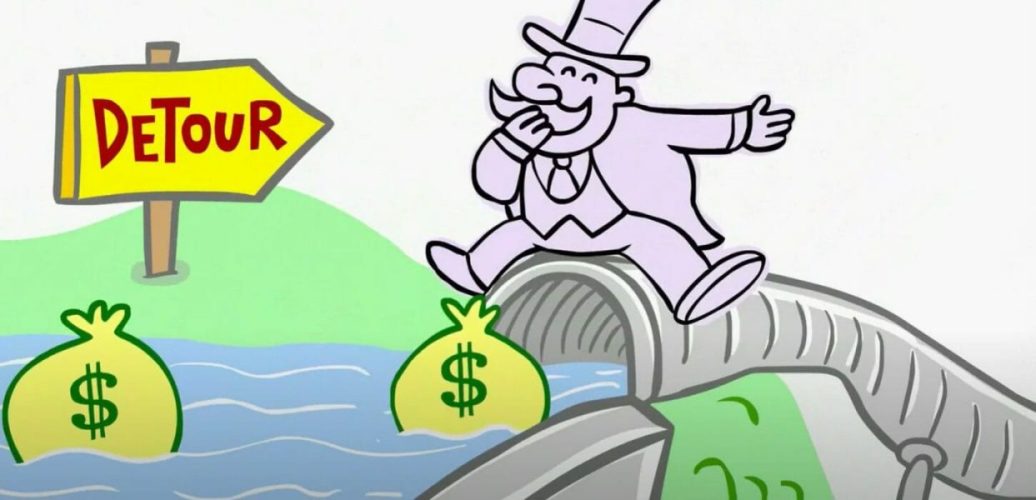We hear a lot of stories about wealthy people giving huge donations to charity. These stories make us think that there is a bountiful river of money flowing from millionaire donors to nonprofit organizations.
But not all of that flow is actually getting where it’s supposed to.
Wouldn’t it be nice if the billions of dollars that wealthy people donate in the name of protecting our environment, feeding the hungry, and building world peace actually reached the charities that are trying to make things better?
Watch our short video explaining how millionaire giving isn’t delivering as many societal benefits as it should — and learn more about what you can do to help.
Wealthy donors have found ways to divert charitable giving.
You see, most of us simply give directly to organizations we care about. But many wealthy donors have found ways to divert charitable giving so that it serves them far more than the causes we thought they were helping.
They get big tax deductions, while at the same time keeping control over the money.
Private foundations
Here’s how it works: If you have a few million dollars to set up what’s called a private foundation, you can donate money to your foundation in the name of the environment, education, world peace, you name it.
You get an immediate tax deduction for doing that – because it’s technically a charitable donation! And the public will love you for it.
But what’s really going on is the money is channeled away from charities.
Because the law says you only need to give 5 percent of your foundation’s assets out each year to charities. The rest of the money can just sit there, piling up. And many foundations unfortunately do just that.
Donor-advised funds
There’s another way to divert donations: donor-advised funds, or “DAFs.”
DAFs are nonprofits that work like charitable bank accounts. If you donate money to a DAF, you get a tax deduction for that right away. Then the money sits there, sidelined, earning fees for investment managers, until you recommend grants from it to whatever charities you want.
But the law says you don’t ever have to make grants from your DAF to charity. And while many DAF donors are generous, others pay out just tiny amounts, or nothing.
That’s right. DAFs are getting bigger and bigger from the money coming in, but charities see very little of it.
Oh — and if you have a foundation, and you don’t want to give a whole 5 percent of its assets to the causes you claim to be supporting, you can give grants to a DAF instead.
Diversion is out of control.
If all this is a bit hard to follow, let’s put it this way:
We’re all paying to give huge charitable tax deductions to the super-rich in exchange for the promise that they’ll help fund a better world.
But many of them are breaking that promise, with the full support of the law.
Right now, more than a third of the money that people donate to charity is being diverted to foundations or DAFs. In 2021, that total was 122 billion dollars – and over the years, it has amounted to hundreds of billions of dollars. More is diverted every day. And that could keep going until the river runs dry.
We have the power to change the rules to get money flowing back to our common good, where it belongs.
We urgently need to overhaul the rules governing philanthropy to discourage the warehousing of charitable wealth, to align tax incentives with the public interest, and to encourage broad-based giving across all segments of society.
Fixing these problems is incredibly popular with the public — on both sides of the aisle.
Take action
The movement to fix the design flaws in the charitable sector is growing. President Biden’s annual budget proposes to prevent private foundations from using donor-advised funds to satisfy their 5% charitable payout requirements.
Help us advocate for a better system now: Sign this petition calling on Congress to adopt the Biden administration’s proposals, closing charitable loopholes in the United States’ final budget
Policy recommendations
The budget proposals are a good step in the right direction. But to move charitable money faster, we need more. To ensure that donations go where they are supposed to, we recommend federal legislation to:
- Double the minimum annual payout requirement for private foundations
- Establish a three-year payout requirement for DAFs
- Exclude excessive overhead from counting toward private foundation payout
- Exclude grants to DAFs from counting toward private foundation payout
- Exclude grants to DAFs from counting toward DAF payout
And to build more equity and public trust in the philanthropic sector, we recommend federal legislation to:
- Create a new public oversight system for foundations and charities
- Mandate that 501(c)(3) nonprofits publish their annual 990 forms
- Require disclosure of donors to and distributions from donor-advised funds and 501(c)(4) dark money groups
- Incentivize lower-dollar donors’ giving with a universal charitable tax deduction
- Ensure the wealthy pay their fair share in taxes to begin with
If you want to get really wonky, as we are wont to, you can examine our full portfolio of proposals here.
Charity reform will serve our common good.
Among other benefits, implementing these reforms would result in a significant amount of additional revenue flowing to working charities. We estimate that charity reform would generate more than $150 billion in additional revenue to working charities over the next three years.
The river of American wealth — and the philanthropy it underwrites — is rushing faster than ever. With fairer laws and a groundswell of people power, we can ensure that everyone flourishes because of it.
